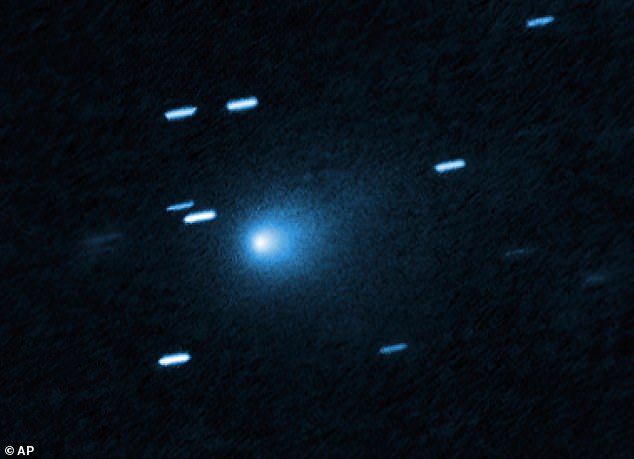The mysterious interstellar object hurtling through our solar system has just given scientists more evidence that it may be a craft from another part of the galaxy.
According to Harvard astrophysicist Avi Loeb, the object dubbed 3I/ATLAS seems to be generating its own light, similar to a vehicle turning on its headlights, but its source is currently a mystery.
The shocking revelation came from a picture an astronomer took of 3I/ATLAS using the Hubble Space Telescope on July 21.
The light from 3I/ATLAS in Hubble’s photo appeared as a glowing area focused on the side of the object facing the sun. It’s not a beam or laser shooting out like a spotlight, nor was it a uniform glow covering the entire surface.
Until now, the prevailing theory has been that the fast-moving object is a giant comet approximately 12 miles long, which will make its closest pass to Earth on December 17.
In a new report, Loeb said this glow might be caused by dust coming off the object’s surface as it is heated by the sun.
However, the glow’s brightness decreases sharply with distance, which doesn’t match how typical comets behave when they reflect sunlight.
According to Loeb, this has added yet another potential clue that 3I/ATLAS might be artificial, containing a powerful source of energy that’s capable of generating light we see from millions of miles away.

A new report on the interstellar object 3I/ATLAS has found that it may be somehow generating its own light, proving it’s not a comet

3I/ATLAS (circled) is expected to make its closest approach to Earth on December 17, 2025
‘3I/ATLAS could be a spacecraft powered by nuclear energy, and the dust emitted from its frontal surface might be from dirt that accumulated on its surface during its interstellar travel,’ Loeb wrote in a statement.
‘This cannot be ruled out, but requires better evidence to be viable,’ he added.
Normally, comets glow because of the dust and gas around them reflecting sunlight. This light usually spreads out more evenly and doesn’t dim as quickly as you move away from the comet’s core.
Scientists expected the brightness of 3I/ATLAS to follow a similar pattern, but instead, it drops off sharply, suggesting the light might be coming from something else entirely.
The discovery was similar to standing near a bright flashlight. The light is intense up close, but as you walk away, it fades fast.
Loeb and his colleague Eric Keto suggested that if 3I/ATLAS is producing its own light, the supposed comet could be much smaller than the 12 miles scientists initially thought.
If it’s creating its light, Loeb estimated that 3I/ATLAS could be as small as 300 feet long, with the object’s brightness fooling our telescopes until it gets closer to Earth.
This would put 3I/ATLAS in a similar size category to Oumuamua, the first interstellar object recorded passing through the solar system in 2017.

Professor Avi Loeb said the light could be hiding the object’s true size, which would be similar to 2017’s interstellar object Oumuamua (pictured)

Loeb has remained adamant that something about 3I/ATLAS does not add up. The new discovery potentially points to a nuclear-powered energy source producing light
Just like 3I/ATLAS, Loeb has remained convinced that Oumuamua was an artificially created spacecraft sent to probe our solar system.
At the time, the scientist noted that Oumuamua displayed the strange ability to speed up without the influence of gravity as it traveled through space.
With 3I/ATLAS, scientists have already noted strange patterns emerging, months before the object makes its closest approach to Earth in December.
In July, Loeb and his team found that 3I/ATLAS was on an extremely unusual course that would take it close to three different planets: Venus, Mars, and Jupiter.
The astrophysicist and UFO researcher explained that the object’s course was so rare that the chance of a natural space rock randomly flying along such a path was less than 0.005 percent.
Astronomers have also found that 3I/ATLAS does not appear to have a coma, the cloud of gas and dust that typically surrounds comets.
Loeb previously said this suggested the giant object could not be a comet, which should have a smaller core and be part of a larger population of interstellar objects.
Loeb explored several other ideas to explain this light. One possibility is that the object is evaporating icy particles as it gets closer to the sun, which could explain the glow and lack of a tail.
However, other natural explanations, like a piece of a star explosion or an object heated by rubbing against space material, seem unlikely because they don’t fit the data researchers have gathered so far.
A black hole or radioactive material wouldn’t produce enough light for telescopes to see. There’s also not enough material in space to cause friction heating.
Scientists hope to get better images when 3I/ATLAS passes close to Mars on October 3.
These new images could help figure out whether 3I/ATLAS is a natural space rock or something more unusual, like a piece of alien technology.
This article was originally published by a www.dailymail.co.uk . Read the Original article here. .

